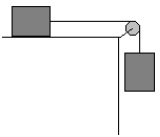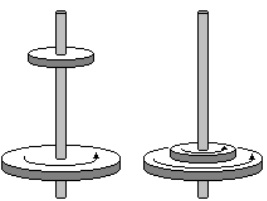Assignment:
Problems:
1) A 15 m ladder of 500 N rests against a frictionless wall. The ladder makes an angle of 60° with the floor. There is friction between the ground and the ladder. (a) Calculate the horizontal and vertical forces acting on the base of the ladder when Skid of 800 N is standing on the ladder 4 m from the bottom. (b) If the ladder is on the verge of slipping when Skid is 9 m up the ladder, calculate the coefficient of static friction between the ladder and the ground.
2) A spherical Yo-Yo is released from rest 1.2 m above the ground. The Yo-Yo unwinds as it falls. What is the Yo-Yo's linear velocity right before it hits the ground?

3) A mass of 8 kg is resting on a horizontal table with a coefficient of kinetic friction of 0.35. The mass is connected to a cable that passes over a pulley of mass 3.5 kg and radius 21 cm. The other end of the cable is attached to a second hanging mass of 15 kg. The system is released from rest. Calculate the angular velocity of the pulley after the masses have moved 1.5 m.
4) A force vector F = 2.0i - 3.0k acts on a pebble with position vector r = 0.5j - 2.0k, relative to the origin. What is the resulting torque acting on the pebble about the origin?
5) A 4.8 m diameter merry-go-round is rotating freely with an angular velocity of 0.8 rad/s. Its total moment of inertia is 1950 kg m2. Skid, Mitch, Larry, and Greezy all jump on the edge of the merry-go-round at the same time. They each have a mass of 65 kg. What is the angular velocity of the merry-go-round now?
6) Disc 1 of mass 5 kg and radius 2.6 m is attached to an axle that is rotating at 20 rad/s. Disc 2 of mass 2 kg and radius 1.7 m is dropped from rest. It slides down the axle and sticks to Disc 1. What is the angular velocity of the two discs?

7) Skid has landing on an asteroid of radius 500 km and gravitational acceleration 3.0 m/s2 .
(a) What will Skid's escape velocity need to be in order to take off in his ship Beggar I?
(b) What will Beggar I's maximum height from the surface be if Skid takes off with a velocity of 1000 m/s?
8) Two identical neutron stars of mass 1030 kg and radius 105 m are separated by a distance of 1010 m. If released from rest, what are the stars' velocities when their separation is one-half of their original?